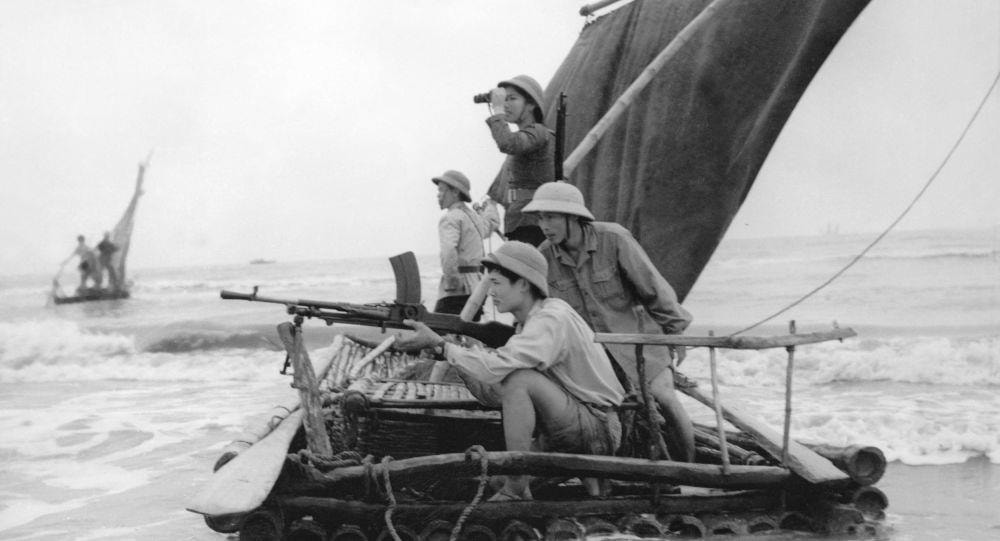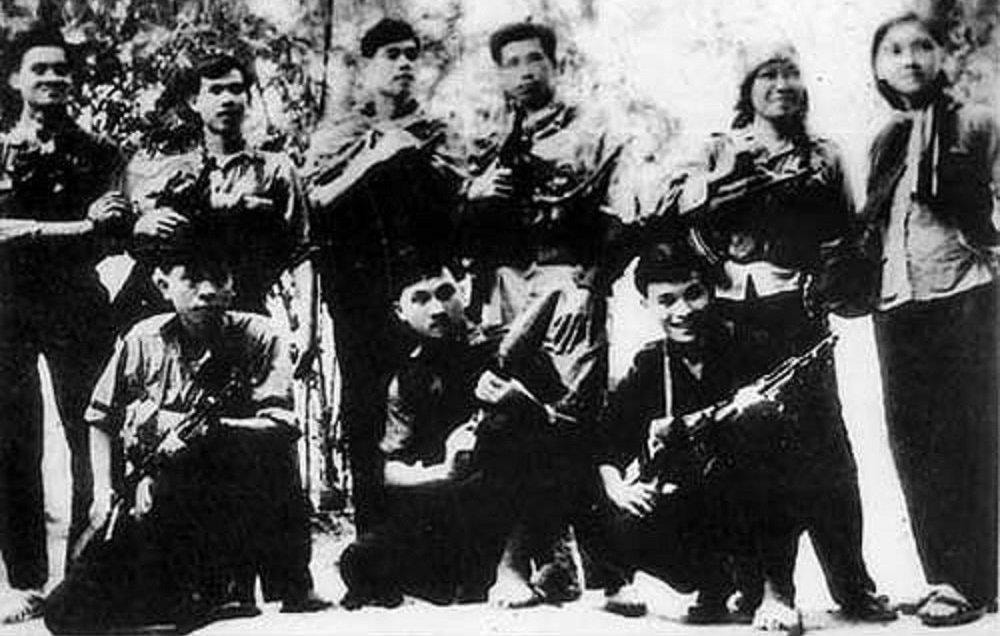Vietnamese special forces and commandos in the 1968 Mau Than campaign
Our special forces and commandos were truly the spearhead of the General Offensive and Uprising in the Spring of Mau Than 1968.
 |
| Vietnamese special forces on homemade rafts on the coast of Nam Ha province in 1972 |
On March 19, 1967, the special forces were recognized by the Party, the Government and the General Command as an official branch of the Vietnam People's Armed Forces.
President Ho Chi Minh, Prime Minister Pham Van Dong and General Vo Nguyen Giap, Minister of National Defense, visited and talked with delegates, officers and soldiers of special forces on the founding day of the force.
President Ho Chi Minh said: "Special forces mean special work, a special honor that requires special efforts... For special forces, the word "special" governs everything, from training to going to battle as well as returning home.
Intelligence must be especially flexible. Technique must be especially well-trained. Political stance must be especially firm…
Discipline must be especially strict. The determination to defeat the enemy and destroy the enemy must also be especially high" (Ho Chi Minh,Complete Works,Vol. 12, National Political Publishing House, Hanoi, 1996, p. 243).
Uncle Ho, the Party Central Committee and the Central Military Commission decided to establish the Special Forces Corps at this time with the immediate intention of using special forces as a shock force in the general offensive.
Firmly grasping the determination of the Politburo and the Central Military Commission, the Special Forces Corps urgently promoted all preparations to participate in the General Offensive.In the North, in 1967, the Special Forces trained 3,835 soldiers, trained 457 deputy platoon leaders, and provided training and transfer training for 527 officers from platoon leader to battalion commander.
Implementing the Party's strategic determination, the service has reinforced the battlefields with 2,563 officers and soldiers.
Organized into a battalion, 40 teams, 7 battalion cadre frames, 30 team cadre frames.
In the southern battlefields, by the end of 1967, the special forces had tens of thousands of soldiers, including 1 regiment, 2 groups (equivalent to regiments), 21 battalions, 58 teams and hundreds of platoons and squads.
 |
| Armed forces of the Saigon - Gia Dinh Special Zone Propaganda Department (T4) before taking part in the 1968 Tet Offensive. |
The special forces have been organized into a system, with leadership from top to bottom to advise commanders of fronts and units in construction and combat.
The Special Forces Command and the fronts advised the Ministry to adjust forces to deploy in strategic areas.
By the end of 1967, in the Saigon suburbs, sub-regions 1, 2, 3, 4, and 5 had one to two light and heavy infantry battalions trained in special operations tactics.
In the inner city of Saigon (Division 6) there are 11 special forces teams, secret militia units, police and armed work teams.Saigon's special forces and commandos built a system of corridors, springboards, and people's bases in the inner city, suburbs, and around important targets, including 19 political bases, 225 base families, 400 hiding points for troops, weapons, and food...
In Hue, in the inner city and suburbs there are 3 special forces battalions and 10 commando teams.
People in the Vien Chinh, Duc Thai, Muc Tra, Duong Mong areas... had prepared food and hundreds of secret tunnels to hide special forces close to the attack target.
In other cities throughout the South, special forces units of the Region, military regions, divisions, main regiments and special forces of provinces and districts were all hidden in key areas and important targets.
On the eve of Tet Mau Than, special forces and commando units were ordered to disperse into many groups, using many different routes to blend into the crowd of people shopping for Tet, secretly hiding troops, weapons, and ammunition in base families or final assembly positions, and at the same time reconnoitring the target one last time.
Tens of thousands of special forces and commandos, and hundreds of tons of special weapons were hidden right in the enemy's heartland.
Our army formation was like sharp knives ready to stab straight into the enemy's throat when ordered to attack.
On the night of January 30, 1968, the General Offensive and Uprising of our army and people broke out simultaneously, strongly, and unexpectedly in Saigon, Hue, and many cities, towns, and townships in the South.
20 minutes later, the Americans came to rescue and were stopped by us outside the main gate.
By morning, a platoon of American soldiers had just entered the embassy. We and the enemy fought fiercely in the embassy grounds.
We captured the first floor, advanced to the second and third floors.
Faced with the tenacious fighting spirit of our soldiers, the Americans had to use helicopters to drop reinforcements from the roof.
At dawn, because we did not receive reinforcements, the battle ended, 16 brave soldiers died. The team leader was seriously injured and captured by the enemy.
The force attacking Saigon Radio Station consisted of 12 soldiers of Special Forces Team No. 4, led by comrade Nguyen Van Tang, cluster leader of clusters 3-4-5, and commanded by comrade Nam Loc.
Our soldiers attacked and stopped the radio from 2am to 5am, but the enemy counterattacked, so we could not capture the target.
Special Forces Team No. 5, consisting of 15 soldiers commanded by comrade Ngo Hoai Thanh, entered the Independence Palace, attacked the palace gate on Nguyen Du Street, and destroyed the guards, but could not deploy in the face of fierce enemy resistance.
The enemy sent armored vehicles to rescue us, forcing us to retreat. In this battle, 8 soldiers were killed and 7 were captured by the enemy.
At other targets, the commando teams all advanced and held until morning, but the spearhead battalions of the sub-regions could not provide timely support.
The commandos fought until the last minute, showing the heroic spirit of the Saigon commandos in the historic moment of Tet Mau Than 1968.
On the outskirts of Saigon, special forces and commandos along with infantry attacked Hanh Thong Tay General Warehouse, Co Loa Artillery Command base, Phu Dong Armored Command, Tan Son Nhat Airport, Nha Be District, the puppet Navy Command, Nha Be oil depot, Tuy Ha Citadel...In Hue, the special forces had 3 battalions and 6 commando teams participating.
Before Tet, units marched in many directions, crossed many rivers and enemy posts to safely assemble at the designated time.
In the North, special forces and commandos were assigned to work with infantry to attack the enemy's 1st Infantry Division headquarters in Mang Ca, the airport and warehouse area in Tay Loc, and the Imperial Citadel area.
To the South, commandos and infantry attacked the puppet armored regiment base in Tam Thai and the US infantry battalion in Nam Giao.
The special forces and commandos in Hue were not large, but together with 8 infantry battalions, they captured and controlled 39 important targets in the city.
The special forces were the core force in capturing the above targets, destroying hundreds of tanks, military vehicles, and airplanes, destroying and capturing nearly a thousand enemies, and together with the local armed forces, launched a strong and widespread uprising among the masses, controlling many areas for long periods of time, some for up to 25 days and nights, including the Imperial Citadel.
From 5:00 a.m. on January 31, 1968, the flag of the National Liberation Front of South Vietnam fluttered on top of the flagpole in front of Ngo Mon Gate.
In Hue, although the coordination between the special forces and the infantry battalions was better, that coordination was still not tight and had not been reinforced in time, so the initial effectiveness of the special forces' capture could not be brought into play, such as:
We could not attack the enemy's 1st Infantry Division headquarters but only surrounded it throughout the entire battle of Hue. We could only hold the airport and Tay Loc warehouse area for 1 day...
During the 1968 Mau Than Spring General Offensive and Uprising, in other cities, towns, and townships throughout the South, special forces were assigned the core task of capturing the most important and dangerous targets such as sub-regions, sub-regions, special zones, provincial roads, district capitals, administrative buildings, police stations, police, commandos, commandos, American and puppet commandos at all levels, advisory areas, prisons, etc.
The above targets were captured and controlled in whole or in part by special forces, creating favorable conditions for the masses to rise up to destroy the ringleaders and villains, disintegrate the puppet government apparatus, and gain control for a certain period of time.
Besides the task of spearheading attacks in urban areas, special forces were also used to attack airports: Tan Son Nhat, Bien Hoa (January 31); Xuan Thieu, Ba Ria (February 5); Cu Hanh (February 7); Dong Tac (February 20)... destroying hundreds of planes, killing hundreds of enemy pilots, limiting their mobility in combat.Special forces also attacked a series of large enemy warehouses such as Hanh Thong Tay, Nha Be, Long Binh (January 31), An Khe (February 17), Deo Son (February 24), burning hundreds of millions of tons of enemy fuel, bombs and ammunition, causing them to fall into a difficult logistical situation in combat.
The battle at Long Binh General Warehouse alone caused the enemy's artillery positions in "tactical zone 3" to fire sparsely due to lack of ammunition.
Special forces also attacked many tank bases, armored vehicles, artillery positions, and important traffic bridges.
In particular, the 126th Water Special Forces Group prevented enemy waterway transport on the Cua Viet River from the last few months of 1967 to the beginning of 1968, besieged Cua Viet port, destroyed 14 enemy ships, and blocked the river section from Thanh Xuan to Cua Viet.
During the operation from late 1967 to mid-1968, culminating in the Mau Than Spring General Offensive and Uprising, the Navy special forces fought bravely in hundreds of battles, sank or damaged more than 100 enemy warships and military transport ships, killed thousands of enemy soldiers, destroyed dozens of bridges, many of their warehouses and war vehicles; contributing to the overall victory of the entire front.
Our special forces and commandos were truly the spearhead of the 1968 Mau Than Spring General Offensive and Uprising, and excellently completed their assigned tasks.

